VOLVO V60 2014 Owner's Guide
Manufacturer: VOLVO, Model Year: 2014, Model line: V60, Model: VOLVO V60 2014Pages: 442, PDF Size: 13.85 MB
Page 31 of 442
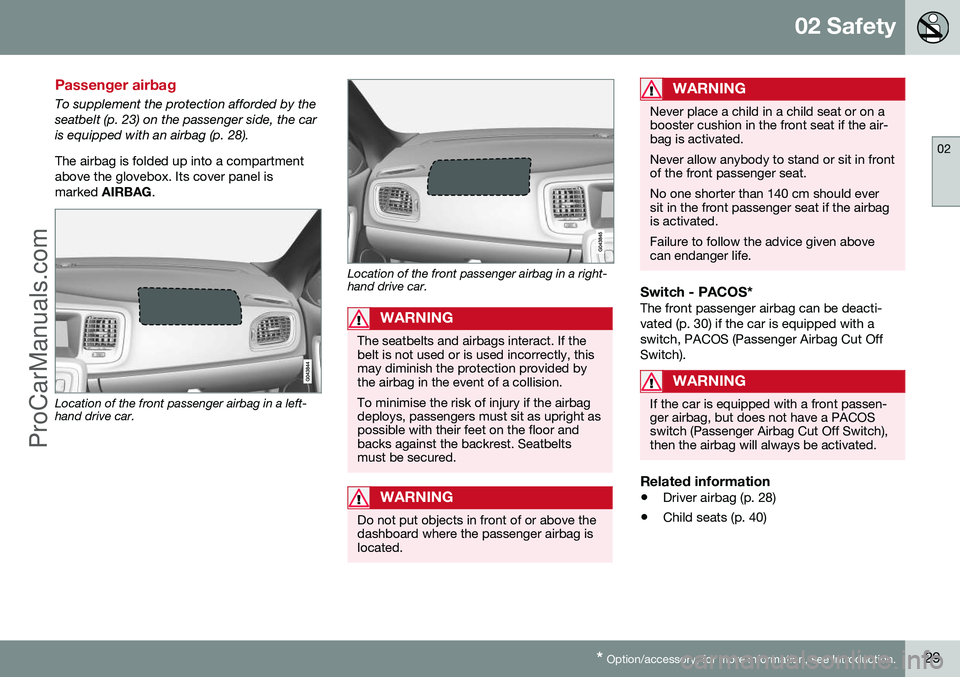
02 Safety
02
* Option/accessory, for more information, see Introduction.29
Passenger airbag
To supplement the protection afforded by the seatbelt (p. 23) on the passenger side, the caris equipped with an airbag (p. 28). The airbag is folded up into a compartment above the glovebox. Its cover panel ismarked AIRBAG .
Location of the front passenger airbag in a left- hand drive car.
Location of the front passenger airbag in a right- hand drive car.
WARNING
The seatbelts and airbags interact. If the belt is not used or is used incorrectly, thismay diminish the protection provided bythe airbag in the event of a collision. To minimise the risk of injury if the airbag deploys, passengers must sit as upright aspossible with their feet on the floor andbacks against the backrest. Seatbeltsmust be secured.
WARNING
Do not put objects in front of or above the dashboard where the passenger airbag islocated.
WARNING
Never place a child in a child seat or on a booster cushion in the front seat if the air-bag is activated. Never allow anybody to stand or sit in front of the front passenger seat. No one shorter than 140 cm should ever sit in the front passenger seat if the airbagis activated. Failure to follow the advice given above can endanger life.
Switch - PACOS*The front passenger airbag can be deacti- vated (p. 30) if the car is equipped with aswitch, PACOS (Passenger Airbag Cut OffSwitch).
WARNING
If the car is equipped with a front passen- ger airbag, but does not have a PACOSswitch (Passenger Airbag Cut Off Switch),then the airbag will always be activated.
Related information
•Driver airbag (p. 28)
• Child seats (p. 40)
ProCarManuals.co’
Page 32 of 442
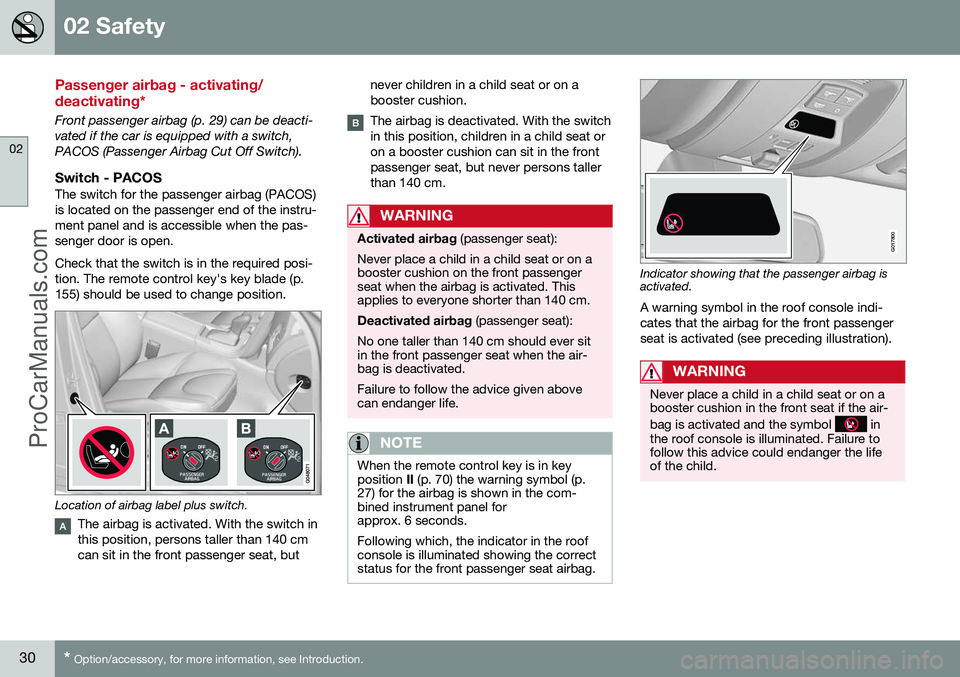
02 Safety
02
30* Option/accessory, for more information, see Introduction.
Passenger airbag - activating/ deactivating*
Front passenger airbag (p. 29) can be deacti- vated if the car is equipped with a switch,PACOS (Passenger Airbag Cut Off Switch).
Switch - PACOSThe switch for the passenger airbag (PACOS)is located on the passenger end of the instru-ment panel and is accessible when the pas-senger door is open. Check that the switch is in the required posi- tion. The remote control key's key blade (p.155) should be used to change position.
Location of airbag label plus switch.
The airbag is activated. With the switch in this position, persons taller than 140 cmcan sit in the front passenger seat, but never children in a child seat or on abooster cushion.
The airbag is deactivated. With the switch in this position, children in a child seat oron a booster cushion can sit in the frontpassenger seat, but never persons tallerthan 140 cm.
WARNING
Activated airbag
(passenger seat):
Never place a child in a child seat or on a booster cushion on the front passengerseat when the airbag is activated. Thisapplies to everyone shorter than 140 cm. Deactivated airbag (passenger seat):
No one taller than 140 cm should ever sit in the front passenger seat when the air-bag is deactivated. Failure to follow the advice given above can endanger life.
NOTE
When the remote control key is in key position II (p. 70) the warning symbol (p.
27) for the airbag is shown in the com-bined instrument panel forapprox. 6 seconds. Following which, the indicator in the roof console is illuminated showing the correctstatus for the front passenger seat airbag.
G017800
Indicator showing that the passenger airbag is activated.
A warning symbol in the roof console indi- cates that the airbag for the front passengerseat is activated (see preceding illustration).
WARNING
Never place a child in a child seat or on a booster cushion in the front seat if the air- bag is activated and the symbol
in
the roof console is illuminated. Failure to follow this advice could endanger the lifeof the child.
ProCarManuals.co’
Page 33 of 442
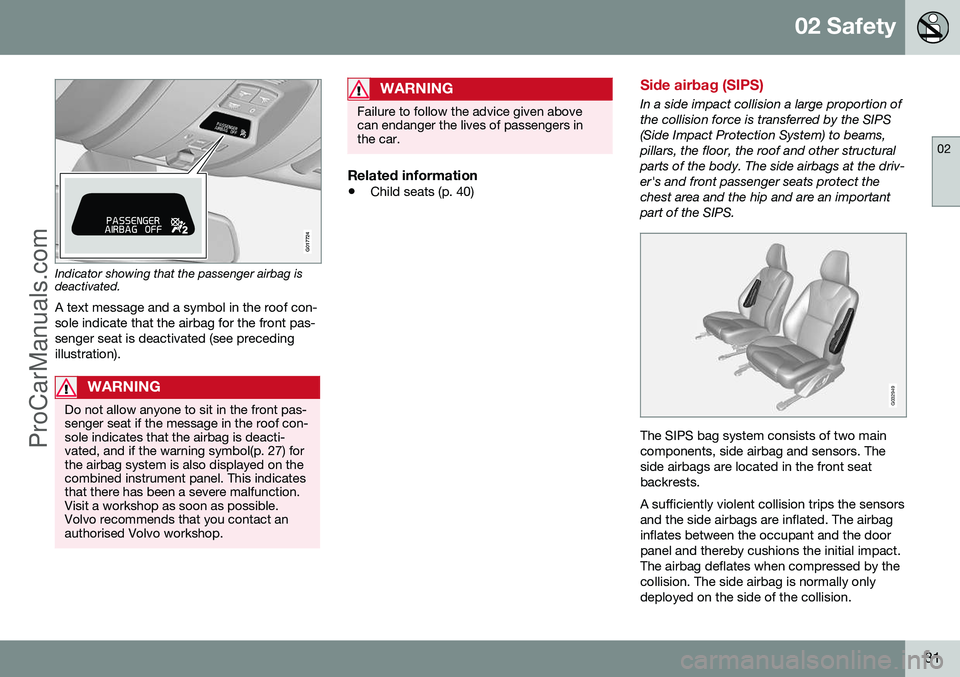
02 Safety
02
31
2
2
G017724
Indicator showing that the passenger airbag is deactivated.
A text message and a symbol in the roof con- sole indicate that the airbag for the front pas-senger seat is deactivated (see precedingillustration).
WARNING
Do not allow anyone to sit in the front pas- senger seat if the message in the roof con-sole indicates that the airbag is deacti-vated, and if the warning symbol(p. 27) forthe airbag system is also displayed on thecombined instrument panel. This indicatesthat there has been a severe malfunction.Visit a workshop as soon as possible.Volvo recommends that you contact anauthorised Volvo workshop.
WARNING
Failure to follow the advice given above can endanger the lives of passengers inthe car.
Related information
• Child seats (p. 40)
Side airbag (SIPS)
In a side impact collision a large proportion of the collision force is transferred by the SIPS(Side Impact Protection System) to beams,pillars, the floor, the roof and other structuralparts of the body. The side airbags at the driv-er's and front passenger seats protect thechest area and the hip and are an importantpart of the SIPS.
G032949
The SIPS bag system consists of two main components, side airbag and sensors. Theside airbags are located in the front seatbackrests. A sufficiently violent collision trips the sensors and the side airbags are inflated. The airbaginflates between the occupant and the doorpanel and thereby cushions the initial impact.The airbag deflates when compressed by thecollision. The side airbag is normally onlydeployed on the side of the collision.
ProCarManuals.co’
Page 34 of 442

||
02 Safety
02
32
Driver's seat, left-hand drive.
Front passenger seat, left-hand drive.
WARNING
•Volvo recommends that repairs are only carried out by an authorised Volvoworkshop. Defective work in the SIPS-bag system could cause malfunctionand result in serious personal injury.
• Do not put objects in the area betweenthe outside of the seat and the doorpanel, since this area is required bythe side airbag.
• Volvo recommends the use only of carseat covers approved by Volvo. Otherseat covers may impede the operationof the side airbags.
• Side airbags are a supplement theseatbelts. Always use a seatbelt.
Related information
•
Driver airbag (p. 28)
• Passenger airbag (p. 29)
• Side airbag (SIPS) - child seat/booster cushion (p. 32)
• Inflatable Curtain (IC) (p. 33)
Side airbag (SIPS) - child seat/booster cushion
The protection provided by the car to children seated in a child seat or on a booster cushionis not diminished by the side airbag (p. 31). Child seat/booster cushion (p. 40) can be placed on the front passenger seat providedthat the car does not have an activated airbag(p. 30) on the front passenger side.
Related information
•Passenger airbag (p. 29)
• General information on child safety (p. 39)
ProCarManuals.co’
Page 35 of 442
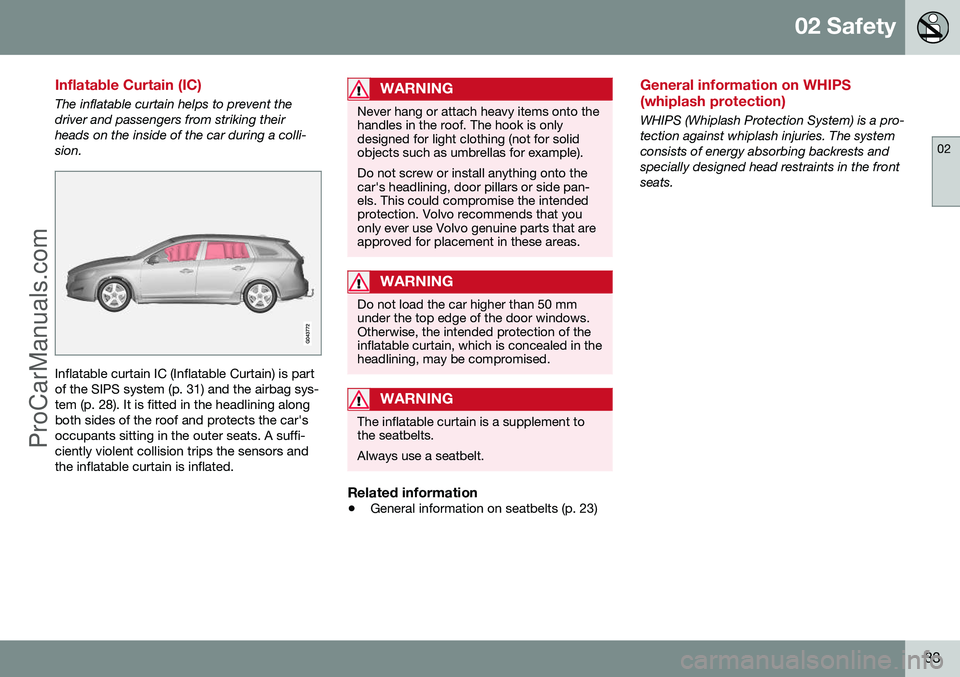
02 Safety
02
33
Inflatable Curtain (IC)
The inflatable curtain helps to prevent the driver and passengers from striking theirheads on the inside of the car during a colli-sion.
Inflatable curtain IC (Inflatable Curtain) is part of the SIPS system (p. 31) and the airbag sys-tem (p. 28). It is fitted in the headlining alongboth sides of the roof and protects the car'soccupants sitting in the outer seats. A suffi-ciently violent collision trips the sensors andthe inflatable curtain is inflated.
WARNING
Never hang or attach heavy items onto the handles in the roof. The hook is onlydesigned for light clothing (not for solidobjects such as umbrellas for example). Do not screw or install anything onto the car's headlining, door pillars or side pan-els. This could compromise the intendedprotection. Volvo recommends that youonly ever use Volvo genuine parts that areapproved for placement in these areas.
WARNING
Do not load the car higher than 50 mm under the top edge of the door windows.Otherwise, the intended protection of theinflatable curtain, which is concealed in theheadlining, may be compromised.
WARNING
The inflatable curtain is a supplement to the seatbelts. Always use a seatbelt.
Related information
•General information on seatbelts (p. 23)
General information on WHIPS (whiplash protection)
WHIPS (Whiplash Protection System) is a pro- tection against whiplash injuries. The systemconsists of energy absorbing backrests andspecially designed head restraints in the frontseats.
ProCarManuals.com
Page 36 of 442
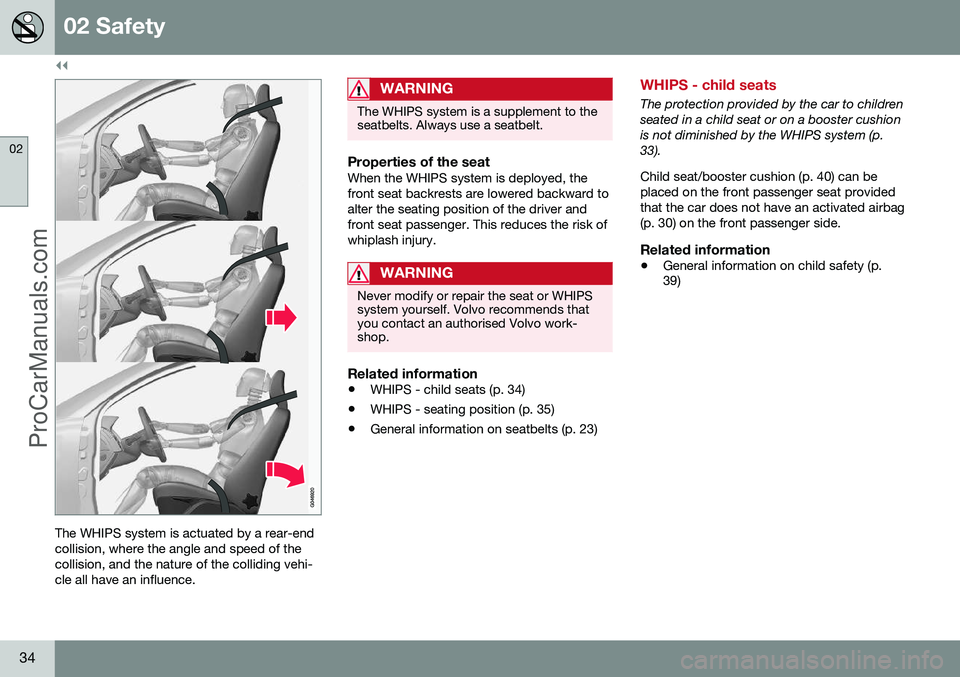
||
02 Safety
02
34
The WHIPS system is actuated by a rear-end collision, where the angle and speed of thecollision, and the nature of the colliding vehi-cle all have an influence.
WARNING
The WHIPS system is a supplement to the seatbelts. Always use a seatbelt.
Properties of the seatWhen the WHIPS system is deployed, the front seat backrests are lowered backward toalter the seating position of the driver andfront seat passenger. This reduces the risk ofwhiplash injury.
WARNING
Never modify or repair the seat or WHIPS system yourself. Volvo recommends thatyou contact an authorised Volvo work-shop.
Related information
•WHIPS - child seats (p. 34)
• WHIPS - seating position (p. 35)
• General information on seatbelts (p. 23)
WHIPS - child seats
The protection provided by the car to children seated in a child seat or on a booster cushionis not diminished by the WHIPS system (p.33). Child seat/booster cushion (p. 40) can be placed on the front passenger seat providedthat the car does not have an activated airbag(p. 30) on the front passenger side.
Related information
•
General information on child safety (p. 39)
ProCarManuals.co’
Page 37 of 442
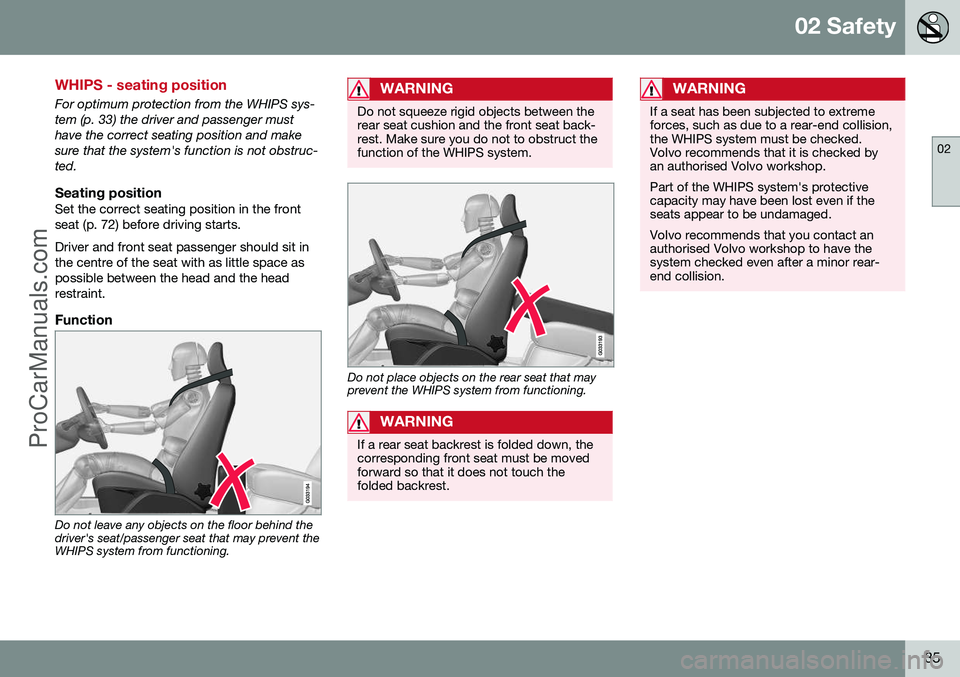
02 Safety
02
35
WHIPS - seating position
For optimum protection from the WHIPS sys- tem (p. 33) the driver and passenger musthave the correct seating position and makesure that the system's function is not obstruc-ted.
Seating positionSet the correct seating position in the frontseat (p. 72) before driving starts. Driver and front seat passenger should sit in the centre of the seat with as little space aspossible between the head and the headrestraint.
Function
Do not leave any objects on the floor behind the driver's seat/passenger seat that may prevent theWHIPS system from functioning.
WARNING
Do not squeeze rigid objects between the rear seat cushion and the front seat back-rest. Make sure you do not to obstruct thefunction of the WHIPS system.
Do not place objects on the rear seat that may prevent the WHIPS system from functioning.
WARNING
If a rear seat backrest is folded down, the corresponding front seat must be movedforward so that it does not touch thefolded backrest.
WARNING
If a seat has been subjected to extreme forces, such as due to a rear-end collision,the WHIPS system must be checked.Volvo recommends that it is checked byan authorised Volvo workshop. Part of the WHIPS system's protective capacity may have been lost even if theseats appear to be undamaged. Volvo recommends that you contact an authorised Volvo workshop to have thesystem checked even after a minor rear-end collision.
ProCarManuals.co’
Page 38 of 442
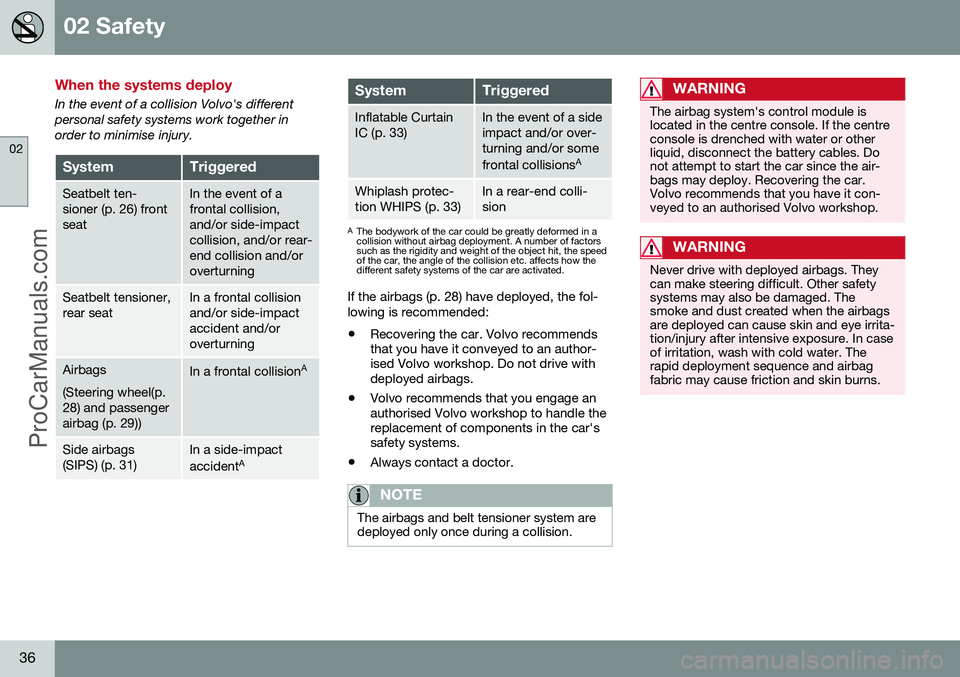
02 Safety
02
36
When the systems deploy
In the event of a collision Volvo's different personal safety systems work together inorder to minimise injury.
SystemTriggered
Seatbelt ten- sioner (p. 26) frontseatIn the event of a frontal collision,and/or side-impactcollision, and/or rear-end collision and/oroverturning
Seatbelt tensioner, rear seatIn a frontal collision and/or side-impactaccident and/oroverturning
Airbags (Steering wheel(p. 28) and passengerairbag (p. 29))In a frontal collisionA
Side airbags (SIPS) (p. 31)In a side-impact accident
A
SystemTriggered
Inflatable Curtain IC (p. 33)In the event of a side impact and/or over-turning and/or some frontal collisions A
Whiplash protec- tion WHIPS (p. 33)In a rear-end colli- sion
A
The bodywork of the car could be greatly deformed in a collision without airbag deployment. A number of factorssuch as the rigidity and weight of the object hit, the speedof the car, the angle of the collision etc. affects how thedifferent safety systems of the car are activated.
If the airbags (p. 28) have deployed, the fol- lowing is recommended: • Recovering the car. Volvo recommends that you have it conveyed to an author-ised Volvo workshop. Do not drive withdeployed airbags.
• Volvo recommends that you engage anauthorised Volvo workshop to handle thereplacement of components in the car'ssafety systems.
• Always contact a doctor.
NOTE
The airbags and belt tensioner system are deployed only once during a collision.
WARNING
The airbag system's control module is located in the centre console. If the centreconsole is drenched with water or otherliquid, disconnect the battery cables. Donot attempt to start the car since the air-bags may deploy. Recovering the car.Volvo recommends that you have it con-veyed to an authorised Volvo workshop.
WARNING
Never drive with deployed airbags. They can make steering difficult. Other safetysystems may also be damaged. Thesmoke and dust created when the airbagsare deployed can cause skin and eye irrita-tion/injury after intensive exposure. In caseof irritation, wash with cold water. Therapid deployment sequence and airbagfabric may cause friction and skin burns.
ProCarManuals.co’
Page 39 of 442
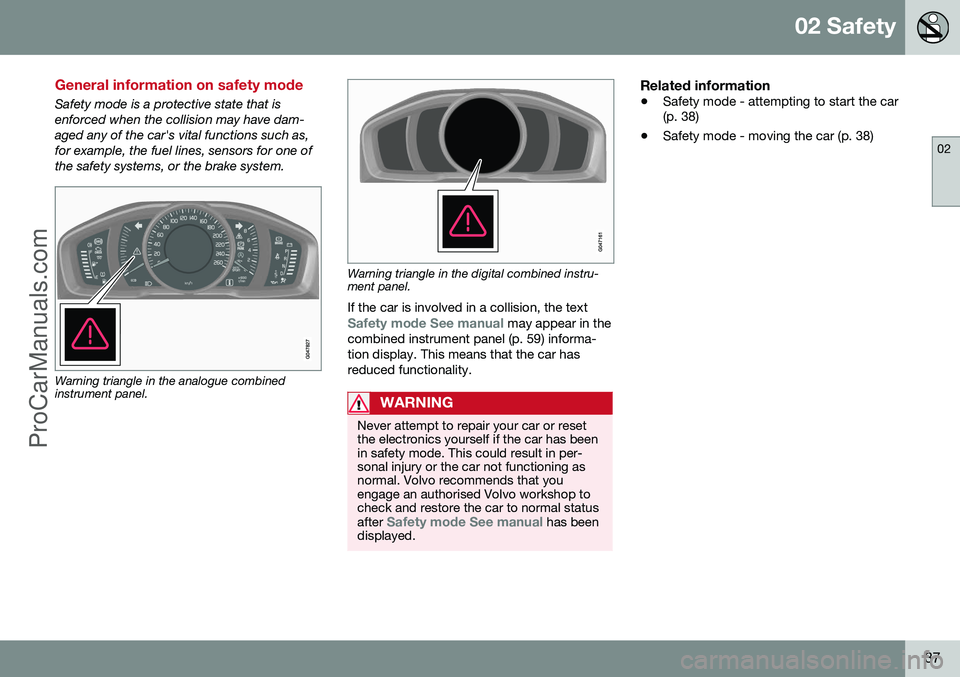
02 Safety
02
37
General information on safety mode
Safety mode is a protective state that is enforced when the collision may have dam-aged any of the car's vital functions such as,for example, the fuel lines, sensors for one ofthe safety systems, or the brake system.
Warning triangle in the analogue combined instrument panel.
Warning triangle in the digital combined instru- ment panel.If the car is involved in a collision, the text
Safety mode See manual may appear in the
combined instrument panel (p. 59) informa- tion display. This means that the car hasreduced functionality.
WARNING
Never attempt to repair your car or reset the electronics yourself if the car has beenin safety mode. This could result in per-sonal injury or the car not functioning asnormal. Volvo recommends that youengage an authorised Volvo workshop tocheck and restore the car to normal status after
Safety mode See manual has been
displayed.
Related information
• Safety mode - attempting to start the car (p. 38)
• Safety mode - moving the car (p. 38)
ProCarManuals.co’
Page 40 of 442
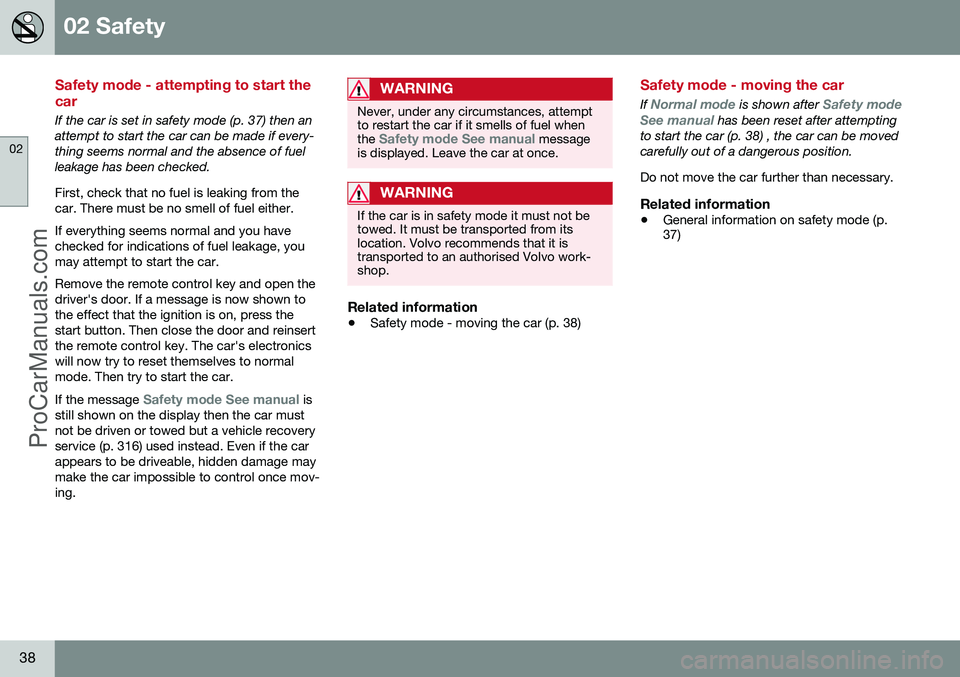
02 Safety
02
38
Safety mode - attempting to start the car
If the car is set in safety mode (p. 37) then an attempt to start the car can be made if every-thing seems normal and the absence of fuelleakage has been checked. First, check that no fuel is leaking from the car. There must be no smell of fuel either. If everything seems normal and you have checked for indications of fuel leakage, youmay attempt to start the car. Remove the remote control key and open the driver's door. If a message is now shown tothe effect that the ignition is on, press thestart button. Then close the door and reinsertthe remote control key. The car's electronicswill now try to reset themselves to normalmode. Then try to start the car. If the message
Safety mode See manual is
still shown on the display then the car must not be driven or towed but a vehicle recoveryservice (p. 316) used instead. Even if the carappears to be driveable, hidden damage maymake the car impossible to control once mov-ing.
WARNING
Never, under any circumstances, attempt to restart the car if it smells of fuel when the
Safety mode See manual message
is displayed. Leave the car at once.
WARNING
If the car is in safety mode it must not be towed. It must be transported from itslocation. Volvo recommends that it istransported to an authorised Volvo work-shop.
Related information
• Safety mode - moving the car (p. 38)
Safety mode - moving the car
If Normal mode is shown after Safety mode
See manual has been reset after attempting
to start the car (p. 38) , the car can be moved carefully out of a dangerous position. Do not move the car further than necessary.
Related information
• General information on safety mode (p. 37)
ProCarManuals.co’